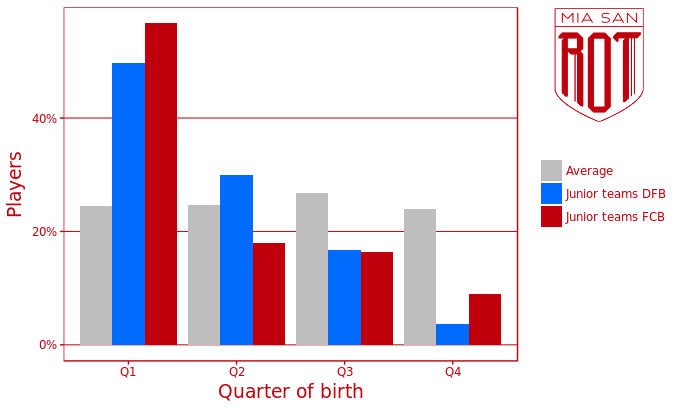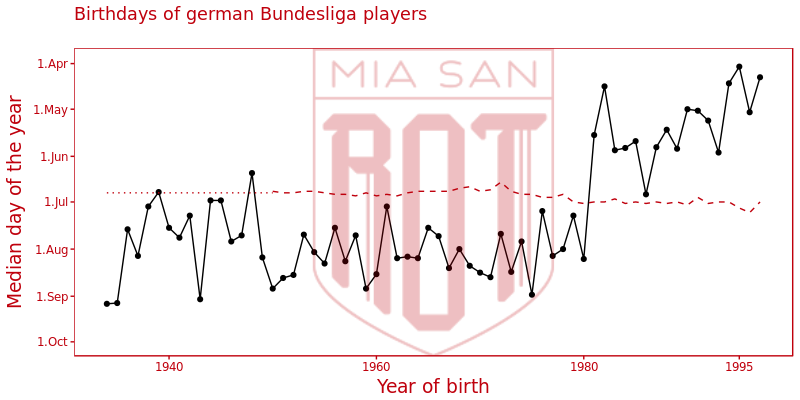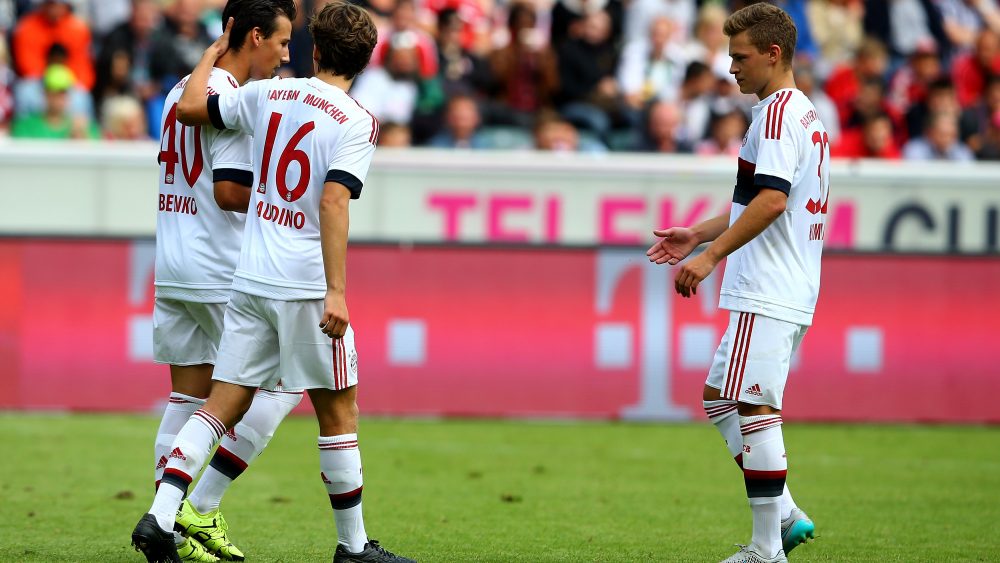Stats & Links: The Relative Age Effect And Philipp Lahm
What is the relative age effect?
The RAE describes the tendency to rather select a player whose birthday is within the first months of the year. The reason behind this lies within the segmentation of young talents into teams born in a specific time frame, usually a civic year.
Consequently it is possible for two players, whose birthdays are as much as 364 days apart, to face off in one match with the physical abilities being the main difference. Older players can mask smaller shortcomings in tactical understanding and technical abilities easier, because of their superb physique. Those players’ talent will be more evident to a scout.
Even former Bayern coach Pep Guardiola was close to being cut from Barcelona’s youth team once. It was only thanks to the great Johann Cruyff, back than coach of Barca’s first team and founding father of the world famous youth academy “La Mesia”, that Guardiola got the deserved recognition of the coaches at Barcelona.
RAE is accompanied by some kind of vicious cycle: Physically stronger players get more recognition and receive specific assistance and training, which further enhances their overall play and lets them gain a lot of experience. Potentially more naturally gifted players are robbed of this opportunity, which narrows their edge in technical abilities on top of their lack in physicality. Their performances seem to languish or even decline.
The RAE was observed and examined for different sports and teams. It unveils flaws in the current system of scouting young talented players. But is this true for Bayern’s youth teams and what are possible counteractions that could be enforced?
Relative age effect in youth teams
In order to evaluate the impact of RAE on the selection of youth players at Bayern, all youth teams from the Under-16s on were examined. This is a total of 67 players.
The German national youth teams were analyzed as well as a comparison. The German football association (DFB) has one youth team per age group and a total of 167 players starting with the Under-16s.
For both Bayern and the DFB the current squads according to the homepage were used. The players then were sorted by their birthday and grouped by their birth quarter.
As a further comparison the birth quarter distribution across the German population between the ages of 14 and 21 was used as well. For each birth quarter the percentage remains almost the same.

For both Bayern’s and Germany’s youth teams the high number of players in the first quarter and low number of players in the last quarter stand out. In Germany’s Under-16s and Under-17s there is not a single player whose birthday is later than September.
Furthermore the Under-19 youth teams from Bayern is striking. Only three of the 24 players on the roster were born later than June. This is eye-catching mainly because the Under-19 is the only youth team with players of two age groups. There seems to be an obvious tendency to players with an early birthday, because in the extreme there could be as much as two years between two players.
Still, FC Bayern tries to counteract this effect. The youth coaches are aware of this fact and try to keep players on the roster, who might not be quite there physically but play on a very high level technically. The perfect example being the current captain of Bayern’s first team – Phillip Lahm. He was born in November.
Another more recent example is Gianluca Gaudino. Gaudino’s birthday is the same as Lahm’s. After his first appearances on Bayern’s first team he was often criticized for his lack of physicality. Currently, Gaudino tries to catch on in the first league in Swiss as he is on a loan from Bayern.
It has to be Bayern’s priority to find a solid middle ground for each youth team of more physical players and others who are smaller but more gifted talentwise.
Relative age effect in professional football
Now we turn our eye to the current Bundesliga players. Is it possible to spot the effects of RAE here as well? In order to find out the mean birthday of current German Bundesliga players was analyzed. The graph depicts this mean birthday for each age group and also shows the mean birthday of the German population in red.

At first glance the tendency to earlier birthdays especially in the youngest age groups is apparent. This trend is more focused from 1980 on. These age groups are the first to go through the German youth academies and training base camps under the supervision of the DFB. Those were build on initiative of former DFB president Gerhard Meyer-Vorfelder as a reaction to the disappointing European Championship 2000.
The accompanying stronger selection of youth players seems to have been affected by RAE. Still, the tendency in the professional area is not as strong as it is in the youth teams. While only three players on Bayern’s current squad (Hummels, Lahm, Alonso) were born in the last quarter of the year, most players were born in the third quarter.
In professional football the physical advantages of players born in the first quarter are not as beneficial as the oldest players of one age group still have to face opponent players several years older. However, several promising talents fly under the radar of most clubs youth scouting system.
Countermeasures
At last some ways are presented in order to counteract the RAE. If these measures are used correctly, they can give one team a decisive edge over their competition. Especially Bayern, who are currently restructuring their youth teams, should look deep into those approaches.
The Swiss football association has already implemented two counteractions as they wait longer before selecting players into a training program. Furthermore, they make out the biological age of players in order to identify talents who are due for a growth spurt.
Another way could be a quota, smaller age groups or a rotation of due dates for the grouping of youth teams. However, all of these described measures have to be enforced by the football association.
Another possible way would be to adapt practice and scouting habits. Possible scenarios include training on a diminished field sizes or practice with fewer players. The individual players would have less time and space for their actions and therefore more talented players could stand out more easily. There are further measures to adapt the design of practice to be more fit for a given age group. This all could lead to a more objective assessment of player’s potential.
Some of those counteractions might seem far fetched now, but those measures can help a team identify the next Phillip Lahm. This would be quite useful as the first team is looking for a new right-back starting next season.
Let’s have a look at the links for this week
Bayern vs 1860 – Derby Day In Munich | Matt Ford | The Set Pieces
Bayern domination threatens Bundesliga: league boss | Ryland James | Yahoo Sports
Real Madrid clash could prove to be the toughest test for Carlo Ancelotti | These Football Times
Mario Götze: the ‘once in a century talent’ who is now fighting to save his career | Philip Oltermann | Guardian
Bayern Munich-Real Madrid UCL quarterfinal ‘master vs. pupil’ – Zidane | Dermot Corrigan | ESPN FC
How Gerd Müller’s 1971-72 season propelled him to greatness | Glenn Billingham | These Football Times
Analysis: The reason behind Thomas Muller’s goal-drought | Samarendranath Soory | Outside Of The Boot
Trailblazer or troublemaker? The legacy of Claudio Pizarro | Peter Galindo | These Football Times
Tactical Analysis: Arsenal 1-5 Bayern Munich | Bayern take full advantage of red card | Saiguhan Elancheran | Outside Of The Boot
Niklas Sule excited for move, says ‘There’s no bigger club than Bayern’ | Mark Lovell | Guardian
Fridolina Rolfö eyes Champions League progression | Sophie Lawson | Vavel
Recent Miasanrot articles
Three things we noticed: FC Bayern lose again against Wolfburg women | Jolle | Dennis
FC Bayern academy: the situation in March 2017 | Martin | Sam & Michael
3 Things We Noticed: Borussia Mönchengladbach – FC Bayern 0-1 (0-0) | Christopher | Bettina
Preview: Borussia Mönchengladbach – FC Bayern | Justin | Luca
Should Bayern’s women sacrifice one or two titles so they don’t squander everything? | Jolle | Sam
Tweets about FC Bayern Stats, Maps, and Graphics
You are currently viewing a placeholder content from X. To access the actual content, click the button below. Please note that doing so will share data with third-party providers.












[…] to Joy of the People, on Twitter, for the link to this article on the Relative Age Effect in Bayern Munich’s teams and the Bundesliga, in […]